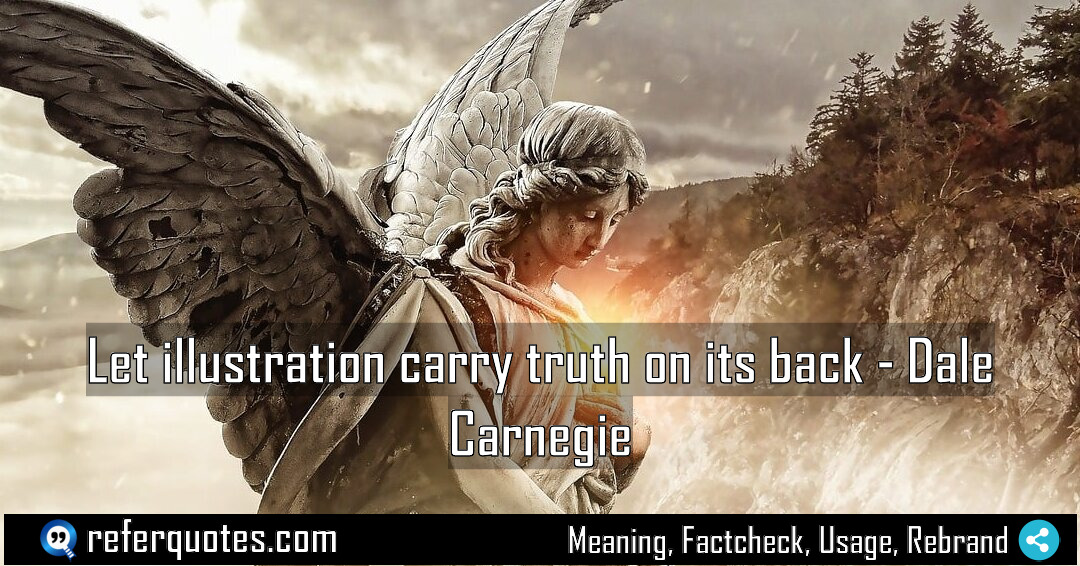
Let illustration carry truth on its back is one of those game-changing principles for any communicator. It’s about making your core message unforgettable by wrapping it in a powerful, relatable story. You’re not just stating facts; you’re giving them a vehicle to travel on.
Share Image Quote:
Table of Contents
Meaning
Don’t just state the truth. Give it a story to ride in on.
Explanation
Look, our brains are wired for narrative, not for data dumps. An abstract concept, a dry statistic, a complex truth… it’s just weight. It’s heavy. It’s hard for people to carry. But when you wrap that same truth in a vivid illustration—a story, an analogy, a concrete example—you’re giving it legs. You’re building a vehicle for it. The illustration does the heavy lifting of engagement and memory, effortlessly carrying your core message straight into the listener’s mind. It’s the difference between describing the theory of gravity and telling the story of Newton and the apple. One is a principle, the other is a picture you never forget.
Quote Summary
Reading Level41
Aesthetic Score74
Origin & Factcheck
This gem comes straight from the classic 1915 public speaking manual, “The Art of Public Speaking,” co-authored by Dale Carnegie and Joseph Berg Esenwein in the United States. It’s a foundational text, and this idea is central to the Carnegie method of influential communication that’s still taught worldwide.
Attribution Summary
Author Bio
Dale Carnegie(1888), an American writer received worldwide recognition for his influential books on relationship, leadership, and public speaking. His books and courses focus on human relations, and self confidence as the foundation for success. Among his timeless classics, the Dale Carnegie book list includes How to Win Friends and Influence People is the most influential which inspires millions even today for professional growth.
Official Website |Facebook | X | Instagram | YouTube |
Where is this quotation located?
| Quotation | Let illustration carry truth on its back |
| Book Details | Publication Year/Date: 1915 (first edition); ISBN/Unique Identifier: 9781420933431 (common Digireads reprint); Last edition. Number of pages: common reprints ~300–480 pages (varies by printing) |
| Where is it? | Part III The Use of Illustration, Unverified – Edition 1915, page range ~120–136 |
Context
In the book, this quote sits right in the middle of a chapter dedicated to making your speech vivid and concrete. The authors were pushing back against the dry, academic, and overly formal oratory of their time. They were telling speakers, “Stop being so abstract. Connect with your audience on a human level.” They argued that illustrations are the bridge between the speaker’s intellect and the audience’s experience.
Usage Examples
I use this all the time. Seriously. Let me give you a couple of ways it plays out.
First, for leaders and managers. You can’t just tell your team “we need to be more innovative.” That truth goes in one ear and out the other. Instead, tell a short story about a time a small, unexpected idea from a junior employee saved a project. That *illustration* carries the “be more innovative” truth directly to them.
Second, for marketers and salespeople. Don’t just list product features. That’s just truth without a vehicle. Create a scenario—a story—about a specific person using your product to solve a painful problem. The story carries the value proposition.
And for educators and trainers, this is your secret weapon. Instead of explaining a complex economic theory, start with a relatable analogy, like comparing supply and demand to a seesaw. The analogy carries the complex concept.
To whom it appeals?
Share This Quote Image & Motivate
Motivation Score60
Popularity Score68
Shareability Score57
FAQ
Question: What’s the difference between an “illustration” and just telling a story?
Answer: Great question. An illustration is a tool with a job. Its sole purpose is to clarify, prove, or amplify a specific point—the “truth.” A story can sometimes just be a story. An illustration is a story with a mission.
Question: Can you overuse this technique?
Answer: Absolutely. If everything is a story, nothing stands out. You become the speaker who cries wolf. The illustrations must be relevant, concise, and in service of the core message, not just decoration.
Question: Is this just for public speaking?
Answer: Not at all. This is for any form of communication where you need to be understood and remembered. Emails, one-on-one conversations, team meetings, marketing copy… if you have a point to make, find a vehicle for it.
Similar Quotes
We believe what we want to believe… It’s a powerful idea that flips our understanding of truth on its head. This isn’t about facts; it’s about the stories we tell…
You know, a lie repeated often enough becomes accepted as truth is one of those concepts that seems almost too simple at first. But the more you see it in…
Look, “The marketer’s task is not to tell the truth…” is a deliberately provocative way of saying we don’t sell features, we sell belief. It’s about framing a narrative so…
You know, the goal of the process is not to find one truth; it’s about a fundamental shift in how we see ourselves. It’s not about uncovering some universal fact,…
Stories spread not because they are true… they spread because they resonate. It’s a game-changer for how we think about marketing and communication. Truth is secondary to belief. Table of…
